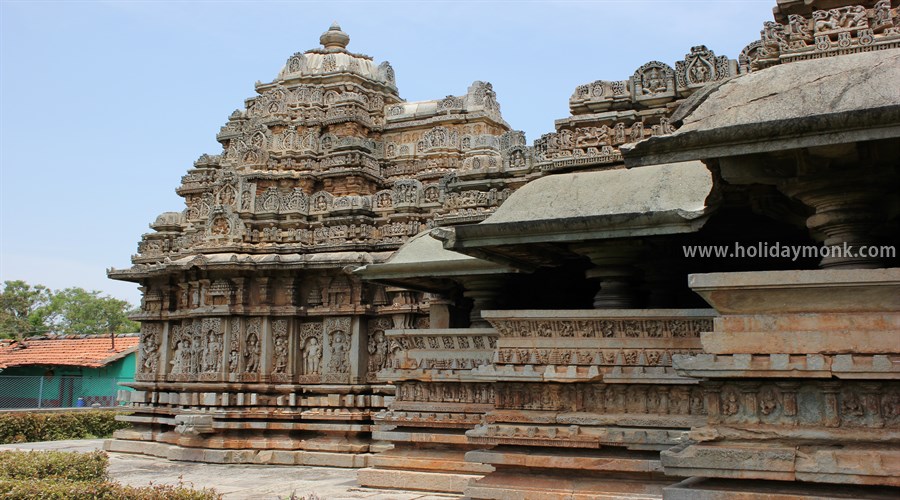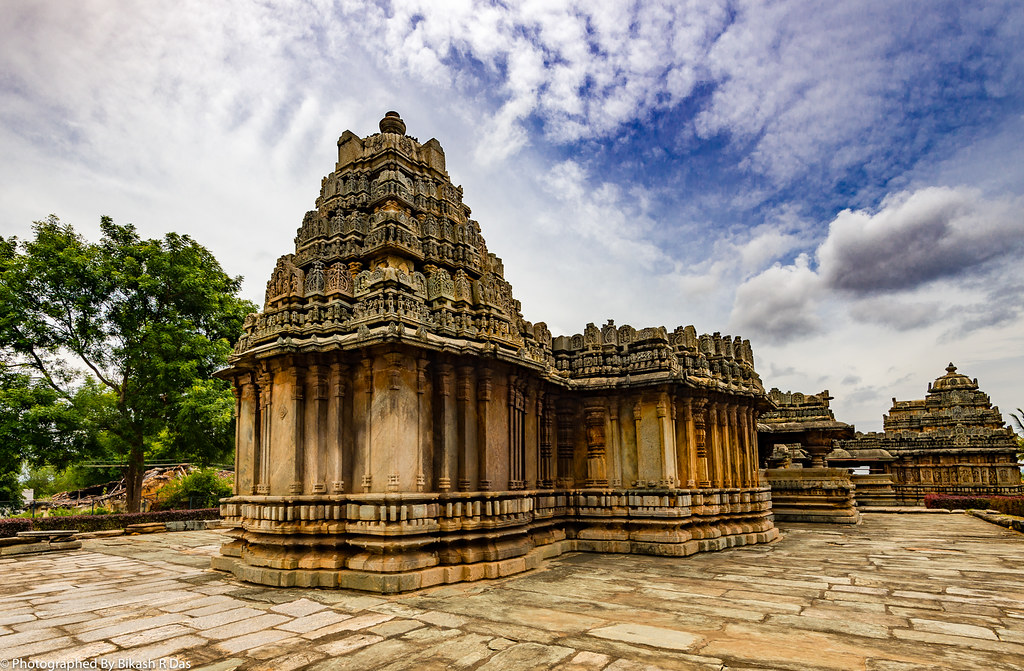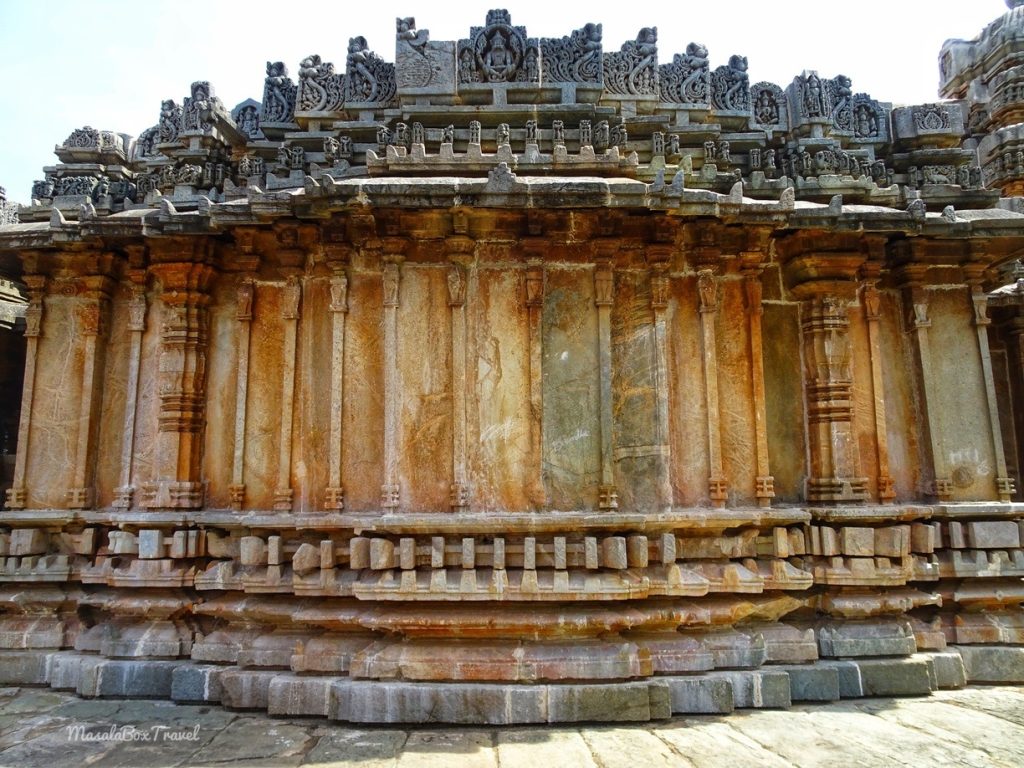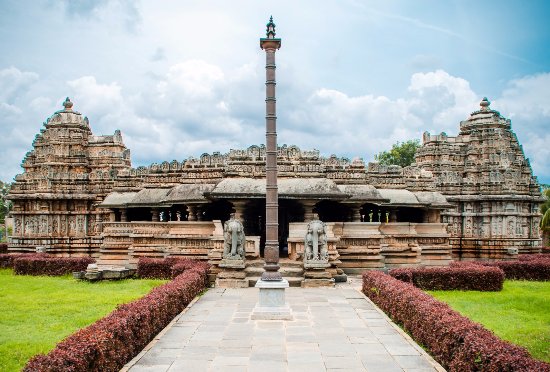VEERA NARAYANA TEMPLE
The Veera Narayana temple, also referred to as the Viranarayana temple of Belavadi, is a triple Hindu temple with a complex Hoysala architecture completed around 1200 CE. Close to Halebidu, this is a better preserved large Hoysala monument found in the small village of Belavadi, Chikkamagaluru district of Karnataka, India.

The temple has three separate square sanctums connected through an unusually large square ranga-mandapa (103 feet). The main shrine faces east and is dedicated to Viranarayana (Vishnu). The north facing shrine is dedicated to Gopala, while the south facing shrine is for Yoga-Narasimha. The temple was likely expanded in stages before it was damaged in the 14th-century, and some features were added to protect it from further destruction. The notable features of this stellate-style temple include its exquisitely ornamented Vesara superstructures (shikara) with jewelry-like details. Inside are the finely polished galaxy of pillars, some banded as if they are wearing jewels. The ceilings too are unusual panels of figural tableaux depicting Hindu legends about Krishna. The Veeranarayana temple is a nationally protected monument of India that is managed by the Archaeological Survey of India Bengaluru Circle.

Belavadi is 11 kilometres (7 mi) north of Halebidu, about 40 kilometres (25 mi) north of Hassan city, and about 29 kilometres (18 mi) southeast of Chikmagalur town on the Chikmagalur-Javagal highway. It is connected to India’s national highway network via NH 73. The local legends state that the village has roots in the Mahabharata era when it was called Ekachakranagar. Then, Belavadi was where Pandava prince Bheema killed the demon Bakasura and protected the village and its people.

The shrines of Veeranarayana were likely built and expanded over many years, because the slightly newer sections has somewhat lesser height, the way the halls connect, and because the cross section plane of the additions is visible. The oldest section is the shrine for Veeranarayana, likely complete about 1200 CE. Thereafter, the temple was expanded where the supersized ranga-mandapa was added along with the shrines for Gopala and Yoga-Narasimha. These were complete by about 1206 CE or few years thereafter.This ornate trikuta (three shrined) temple was built in 1200 C.E. by Hoysala Empire King Veera Ballala II. The material used is Soapstone. Each of the three shrines has a complete superstructure (tower on top of shrine) and is one of the largest temples built by the Hoysala kings. While the famous temples at Belur and Halebidu are known for their intricate sculptures, this temple is known for its architecture.

The plan of the temple is unique in that two of the shrines face each other and are located on either side of a wide and spacious open mantapa (hall) containing thirty seven bays. The temple complex has two closed mantapas, one with thirteen bays and another with nine bays, at the end of which is a central shrine. This third shrine is an older construction and exhibits a standard architectural idiom containing all the basic elements of a Hoysala temple. The inner walls of the older shrine are plain, but its roof is well decorated. In all, the temple complex has fifty nine bays (hence it has many pillars), most of which are lathe-turned and bell shaped, while a few have decorative carvings on them. According to Foekema, the outer wall of the temple is of the “old style”, with one eaves running around the temple where the superstructure meets the wall of the shrine. Below this are miniature decorative towers on pilasters (aedicule). This is followed by a second eves. A panel of Hindu deities and their attendants (frieze) are below this eves followed by a set of five moldings that form the base of the wall.
Thanks for reading.